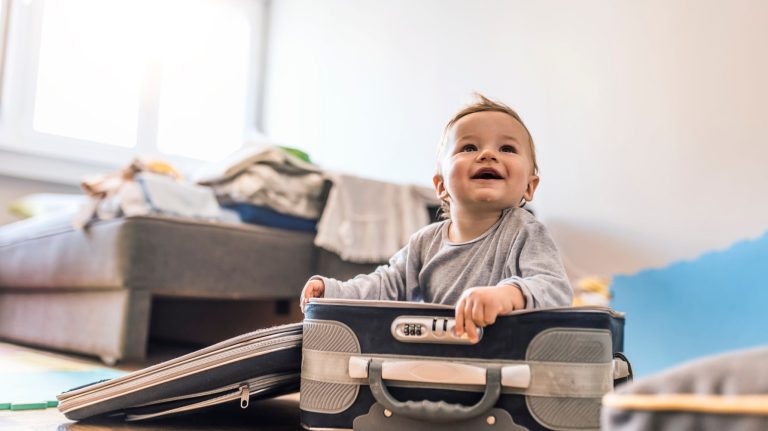
Traveling with a Baby: Smart Ways to Handle Sleep on the Go
- Created:
6. 5. 2025 - Updated:
17. 4. 2025
Traveling with a baby can be full of beautiful firsts—first family vacation, first flight, first time meeting faraway relatives. But let’s be honest: it can also throw your baby’s carefully crafted sleep routine straight out the window. Especially if sleep regression decides to join the trip.
As families gear up for holiday travel—whether it’s a road trip with a baby to grandma’s house, a flight to see relatives, or a well-earned vacation—many parents notice their little one suddenly struggling to sleep. The truth is, even babies who usually snooze like champs can experience setbacks when routines change.
The good news? You can still enjoy traveling with a baby (and get some rest!) by understanding how travel affects your baby’s sleep and preparing with a few smart strategies.
Why Traveling Can Trigger Sleep Regressions
Sleep regressions are temporary periods where your baby’s sleep gets, well… rocky. Your once-good sleeper may suddenly resist bedtime, wake up more often, or seem fussier than usual. These changes are often linked to developmental leaps, teething, or disruptions in routine.
Travel, no matter how exciting, introduces all three.
Think: different time zones, unfamiliar beds, new faces, loud environments, and overstimulating days packed with activities. Even a shift in temperature or light in a new bedroom can mess with your baby’s sleep signals. Add in the physical discomfort of long car rides or flights, and it’s no surprise your baby might protest bedtime.
How to Prepare for Travel with a Baby (and Prevent Sleep Disruptions)
Stick (as best you can) to your routine
While travel always involves some level of change, doing your best to stick to your baby’s usual routine can make a big difference. Aim to keep naps and bedtimes within their regular windows and bring comforting items from home, such as:
- A favorite stuffed animal or lovey
- A travel white noise machine
- Their familiar sleep sack or pyjamas
- A pacifier (or two—just in case one disappears mid-flight)
And here’s a pro move: use a baby monitor app like the Annie Baby Monitor. It turns your phone and an extra device (like a second phone or tablet) into a reliable, crystal-clear baby monitor—no Wi-Fi required. Whether you’re in a hotel room or staying at your in-laws’ house, it gives you peace of mind that your baby is safe and sound while you sneak a few moments to relax. Bonus: it’s easy to pack because it’s already on your phone.
| ✈️ Tip: Download the Annie Baby Monitor app before your trip and test it at home. It’s a simple way to feel more in control during your travels—especially during nap time in unfamiliar places. |
Adjust for time zones ahead of time
If your trip involves crossing time zones, try adjusting your baby’s schedule gradually before you leave. Move bedtime earlier or later by 15–30 minutes each day until it lines up with your destination. It’s a gentle way to ease into the new rhythm—without total chaos on day one.
Keep expectations flexible
No matter how prepared you are, some disruptions are bound to happen. And that’s okay. Don’t let one rough night convince you all is lost. Travel will throw off routines—but with patience and flexibility, things will bounce back. Focus on the experience, not perfection.
Managing Baby’s Sleep While You Travel
Create a cosy sleep environment
Whether you’re staying in a hotel, Airbnb, or family guest room, make the space feel like home. Use portable blackout curtains (or hang a towel over the window in a pinch), bring along your baby’s sleep gear, and set up a white noise machine or app to block out unfamiliar sounds.
When flying, try booking seats with extra room or request a bassinet for long-haul trips. And don’t underestimate the magic of a rear-facing car seat during road trips—just remember to build in plenty of breaks for fresh air and snuggles.
Stick with your sleep rituals
Bedtime routines are golden. Even if your surroundings are unfamiliar, sticking to the same steps—like a warm bath, a favorite lullaby, or a short story—can help your baby recognize that it’s time to sleep. Familiar routines are comforting and help signal that despite the new place, the pattern is the same.
Watch for overtired cues
With so much going on, babies can become overstimulated and overtired fast. If your little one starts rubbing their eyes, getting extra clingy, or crying more than usual, it might be time to wind down. Gentle rocking, a quiet walk in a stroller, or snuggling in a carrier can help soothe them back into a calmer state.
Plan quiet breaks during the day
Between sightseeing, family dinners, and festive activities, try to build in downtime. Babies need a break from the sensory overload just as much as we do. Find a calm spot to rest or nurse, let your baby nap on the go, and use this quiet time to reset. It’s good for both of you.
Getting Back on Track After the Trip
The return home might come with some sleep hiccups too. Your baby may wake up more often or resist naps while they re-adjust to their normal surroundings.
To help ease the transition:
- Reinstate familiar routines right away
- Unpack comforting items like their lovey or sound machine
- Stay consistent and give it a few days—they’ll settle back in
And remember: sleep setbacks from travel aren’t permanent. With some patience and consistency, your baby’s rhythm will return.
Conclusion
Traveling with a baby doesn’t have to mean sacrificing sleep (yours or theirs). By preparing ahead, keeping routines consistent, and packing smart tools like the Annie Baby Monitor, you can navigate the challenges and still soak up all the sweet moments travel brings.
It’s okay if things aren’t perfect. What matters most is being together, making memories, and giving yourself (and your baby) plenty of grace. Sleep will find its way back—promise.






